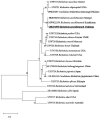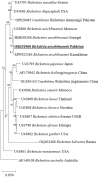First report of spotted fever group Rickettsia aeschlimannii in Hyalomma turanicum, Haemaphysalis bispinosa, and Haemaphysalis montgomeryi infesting domestic animals: updates on the epidemiology of tick-borne Rickettsia aeschlimannii
- PMID: 38163073
- PMCID: PMC10756324
- DOI: 10.3389/fmicb.2023.1283814
First report of spotted fever group Rickettsia aeschlimannii in Hyalomma turanicum, Haemaphysalis bispinosa, and Haemaphysalis montgomeryi infesting domestic animals: updates on the epidemiology of tick-borne Rickettsia aeschlimannii
Abstract
Tick-borne Rickettsia spp. have long been known as causative agents for zoonotic diseases. We have previously characterized Rickettsia spp. in different ticks infesting a broad range of hosts in Pakistan; however, knowledge regarding Rickettsia aeschlimannii in Haemaphysalis and Hyalomma ticks is missing. This study aimed to obtain a better understanding about R. aeschlimannii in Pakistan and update the knowledge about its worldwide epidemiology. Among 369 examined domestic animals, 247 (66%) were infested by 872 ticks. Collected ticks were morphologically delineated into three genera, namely, Rhipicephalus, Hyalomma, and Haemaphysalis. Adult females were the most prevalent (number ₌ 376, 43.1%), followed by nymphs (303, 34.74%) and males (193, 22.13%). Overall, genomic DNA samples of 223 tick were isolated and screened for Rickettsia spp. by the amplification of rickettsial gltA, ompA, and ompB partial genes using conventional PCR. Rickettsial DNA was detected in 8 of 223 (3.58%) ticks including nymphs (5 of 122, 4.0%) and adult females (3 of 86, 3.48%). The rickettsial gltA, ompA, and ompB sequences were detected in Hyalomma turanicum (2 nymphs and 1 adult female), Haemaphysalis bispinosa (1 nymph and 1 adult female), and Haemaphysalis montgomeryi (2 nymphs and 1 adult female). These rickettsial sequences showed 99.71-100% identity with R. aeschlimannii and phylogenetically clustered with the same species. None of the tested Rhipicephalus microplus, Hyalomma isaaci, Hyalomma scupense, Rhipicephalus turanicus, Hyalomma anatolicum, Rhipicephalus haemaphysaloides, Rhipicephalus sanguineus, Haemaphysalis cornupunctata, and Haemaphysalis sulcata ticks were found positive for rickettsial DNA. Comprehensive surveillance studies should be adopted to update the knowledge regarding tick-borne zoonotic Rickettsia species, evaluate their risks to humans and livestock, and investigate the unexamined cases of illness after tick bite among livestock holders in the country.
Keywords: Haemaphysalis bispinosa; Haemaphysalis montgomeryi; Hyalomma turanicum; Rickettsia aeschlimannii; ticks.
Copyright © 2023 Majid, Almutairi, Alouffi, Tanaka, Yen, Tsai and Ali.
Conflict of interest statement
The authors declare that the research was conducted in the absence of any commercial or financial relationships that could be construed as a potential conflict of interest.
Figures




Similar articles
-
Molecular Survey of Rickettsia raoultii in Ticks Infesting Livestock from Pakistan with Notes on Pathogen Distribution in Palearctic and Oriental Regions.Vet Sci. 2023 Oct 29;10(11):636. doi: 10.3390/vetsci10110636. Vet Sci. 2023. PMID: 37999459 Free PMC article.
-
Molecular Detection of Rickettsia hoogstraalii in Hyalomma anatolicum and Haemaphysalis sulcata: Updated Knowledge on the Epidemiology of Tick-Borne Rickettsia hoogstraalii.Vet Sci. 2023 Oct 4;10(10):605. doi: 10.3390/vetsci10100605. Vet Sci. 2023. PMID: 37888557 Free PMC article.
-
Molecular evidence of Borrelia theileri and closely related Borrelia spp. in hard ticks infesting domestic animals.Front Vet Sci. 2023 Nov 28;10:1297928. doi: 10.3389/fvets.2023.1297928. eCollection 2023. Front Vet Sci. 2023. PMID: 38089703 Free PMC article.
-
Ticks and tick-borne pathogens of domestic animals in Somalia and neighbouring regions of Ethiopia and Kenya.Acta Trop. 2023 Jul;243:106944. doi: 10.1016/j.actatropica.2023.106944. Epub 2023 May 12. Acta Trop. 2023. PMID: 37178993 Review.
-
Tick-, flea- and mite-borne pathogens and associated diseases of public health importance in Bangladesh: a review.Infect Med (Beijing). 2024 Oct 19;3(4):100146. doi: 10.1016/j.imj.2024.100146. eCollection 2024 Dec. Infect Med (Beijing). 2024. PMID: 39687692 Free PMC article. Review.
Cited by
-
Molecular detection of Rickettsia aeschlimannii, Candidatus Rickettsia shennongii, Rickettsia sp. and Coxiella burnetii in ticks collected from camels.Sci Rep. 2024 Sep 27;14(1):22129. doi: 10.1038/s41598-024-73663-7. Sci Rep. 2024. PMID: 39333333 Free PMC article.
-
Investigation of Hyalomma turanicum and Hyalomma asiaticum in Pakistan, with notes on the detection of tickborne Rickettsiales.Front Vet Sci. 2024 Dec 23;11:1500930. doi: 10.3389/fvets.2024.1500930. eCollection 2024. Front Vet Sci. 2024. PMID: 39764368 Free PMC article.
-
Genomic characteristics of emerging human pathogen Rickettsia aeschlimannii isolated from two Hyalomma tick species.iScience. 2025 Feb 21;28(3):112080. doi: 10.1016/j.isci.2025.112080. eCollection 2025 Mar 21. iScience. 2025. PMID: 40124488 Free PMC article.
-
Babesia bigemina and Theileria annulata infections in cattle: molecular detection, phylogenetic analysis, and assessment of risk factors.Trop Anim Health Prod. 2024 Sep 26;56(8):282. doi: 10.1007/s11250-024-04122-8. Trop Anim Health Prod. 2024. PMID: 39322769
References
-
- Akveran G. A., Karasartova D., Keskin A., Comba A., Celebi B., Mumcuoglu K. Y., et al. . (2020). Bacterial and protozoan agents found in Hyalomma aegyptium (L., 1758) (Ixodida: Ixodidae) collected from Testudo graeca L., 1758 (Reptilia: Testudines) in Corum Province of Turkey. Ticks Tick-borne Dis. 11:101458. doi: 10.1016/j.ttbdis.2020.101458, PMID: - DOI - PubMed
-
- Ali A., Khan M.A., Zahid H., Yaseen P. M., Qayash Khan M., Nawab J., et al. . (2019). Seasonal dynamics, record of ticks infesting humans, wild and domestic animals and molecular phylogeny of Rhipicephalus microplus in Khyber Pakhtunkhwa Pakistan. Frontiers in Physiology 10:793. doi: 10.3389/fphys.2019.00793 - DOI - PMC - PubMed
LinkOut - more resources
Full Text Sources
Miscellaneous

